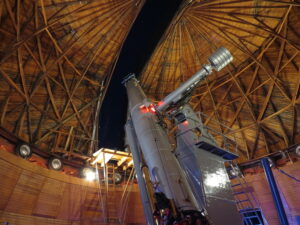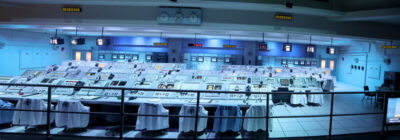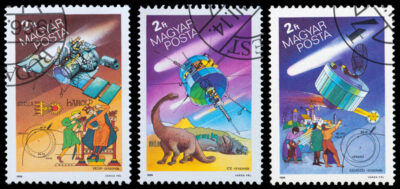Asteroids, beware! As we reported in the previous blog, humans can crash a spacecraft into a heavenly body, like an asteroid. Thus, our first line of planetary defense was officially accomplished on Sept.26. With our second blog on this topic, we aim to show you why it was much more than an explosion.
The DART intentionally impacted the target asteroid, Dimophos. And we now know for certain, the crash deflected the asteroid from its orbit. Thus, Asteroids Beware! Earthlings have a planetary defense against you.
Asteroids Beware: DART Has Made History
Currently, from the mighty lens of the Hubble Space Telescope, we see the debris crater. Likewise, Hubble sent us an image that looks like a comet’s tail streaming from the crash site on Dimorphos. And it’s a tail that changes every day. To give you a mental image, we see a double plume of Disney animation-style magical stardust trailing from the crash site on the asteroid.
It’s technically called “ejecta.” It is made of asteroid debris, simply rocks, large and small. Scientists will continue to study that oddity a long time to come.
Asteroids Beware: A Geyser of Asteroid Debris Changes Day-to-Day
The crash blasted the debris from the surface of Dimorphos and 285 hours later, we received the image. The scientists are learning from observing the movement and shifting of the tail, “how it moves in space, in order to better understand the asteroid.” Dimorphos was a harmless asteroid. However, only experiments like DART will show us how to actually defend earth if a large asteroid develops a threatens us. Thus, DART crashed to see if it could change the asteroid’s orbit.
The Fact-Finding Mission Beyond the Explosion
To put it in scientific words, data from NASA’s DART “shows the spacecraft’s kinetic impact with its target asteroid, Dimorphos…” A kinetic impact is an explosion. And the team added that the explosion “…successfully altered the asteroid’s orbit.”
NASA stated two important findings.
1. “This marks humanity’s first time purposely changing the motion of a celestial object…”
2. “And the first full-scale demonstration of asteroid deflection technology.” (As we stated above, our previous blog, which is technically Part I of this story, featured more DART details. However, we did not know the extent of the success of its mission until now.)
DART Accomplished its Mission Beyond Expectation
Here at ER Precision Optics, we thought readers would like to know what happened after the crash. Thus, let’s examine a little fascinating data. Keep in mind that the DART spacecraft was never supposed to blow up Dimorphos. As we explained previously, it was intended to nudge it out of orbit.
Asteroids, Beware: NASA Renders You Harmless

The DART mission proved earth can defend itself from asteroids.
1. Before the spacecraft crashed into the asteroid, Dimorphos required 11 hours, 55 minutes to orbit its parent asteroid, Didymos.
2. Before and after the little spacecraft smashed itself into Dimorphos, the team measured and studied the orbit meticulously.
3. Using telescopes, the effectiveness of DART’S crash was monitored meticulously. How do you measure a comparable orbit? With time.
4. Now, they know how much time it takes for the DART injured Dimorphos to make its orbit around Didymos. Is there a difference?
5. NASA confirms that “the spacecraft’s impact altered Dimorphos’ orbit around Didymos by 32 minutes…”

Asteroids, Beware! Astronomers from all over the world will be studying DART’s data to defend Earth.
Thus, we can see the impact shortened the 11-hour and 55-minute orbital trip to 11 hours and 23 minutes. The scientists carefully stated a small disclaimer, saying, “This measurement has a margin of uncertainty of approximately plus or minus 2 minutes.”
The Gold Standard of Asteroid Nudging
Previous to the flight, NASA believed that the DART spacecraft would accomplish its mission if it could change the orbit period of Dimorphos by 73 seconds.
As you can see from the math above, DART “surpassed this minimum benchmark by more than 25 times.”

A Quiet view of NASA Mission Control: You can imagine the excitement as the DART impacted the target asteroid.
That is quite an accomplishment for a spacecraft no bigger than a refrigerator.
NASA Administrator Bill Nelson stated proudly, “This mission shows that NASA is trying to be ready for whatever the universe throws at us.” And he concluded, “This is a watershed moment for planetary defense and all of humanity, demonstrating commitment from NASA’s exceptional team and partners from around the world.”
Optical Technology Continues the Mission

Some say asteroids extinguished the dinosaurs. Never before could a species control such an extinction disaster.
It’s almost like the DART mission has just begun because earth-based observatories all over the world continue to collect data from the flight of the DART, its’ crater, and its’ ejecta.
Naturally, ER Precision Optics appreciates all the optical data that makes this investigation continue. Put simply, without optics, Silicon, and Germanium crystals, none of the telescopes could accomplish their readings.
To Whom Kudos are Due
We take a moment to compliment the radar facilities at NASA Jet Propulsion Laboratory’s Goldstone planetary radar in California. Furthermore, ER Precision Optics congratulates the National Science Foundation’s Green Bank Observatory in West Virginia. In regards to the data of the DART project, these radar installations continue to use their sophisticated instrumentation. They are constantly making “period measurements with frequent observations to improve its precision.”
A Continuous Post Flight De-briefing for DART:
Scientists are now concentrating on studying the “efficiency of momentum transfer from DART’s roughly 14,000-mile (22,530-kilometer) per hour collision with its target.
Thus, they are refining the data from the “ejecta” mentioned above. Let’s put the reasons for their long-term study in three main points:
1. A Payload of Data
The ejecta is not just a little bit of space dust. It is hundreds of tons of rocks. The shape and size give us more facts about asteroids and their orbits.
2. A Traffic Maneuver on the Orbit of A Celestial Body
Humanity put that double tail on the asteroid as the DART spacecraft impacted the surface.
The “recoil” from this blast of debris helped propel the spacecraft’s “push against Dimorphos…” (See How, in Number 3, Below.)
3. A Power Balloon Explanation for the Power of Kinetic Impact
NASA states that the ejecta of variegated space rocks acted like a “jet of air streaming out of a balloon,” Just as the air streams of a balloon, the stream of rock sends the balloon of the explosion in the opposite direction. Thus, the crashing spacecraft deflected the orbit of the asteroid.
Asteroids Beware—We Are Learning Your Secrets
Now we can further study the characteristics of an asteroid’s surface. We will discover its strength and its weaknesses. Indeed, we still have a great deal of data to investigate.
“DART has given us some fascinating data about both asteroid properties and the effectiveness of a kinetic impactor as a planetary defense technology,” said Nancy Chabot, the DART coordination lead from the Johns Hopkins Applied Physics Laboratory (APL) in Laurel, Maryland.
Asteroids, Beware! Clock Ticks on Tomorrow’s Plan
We have four years to study the data and images from the Light Italian CubeSat for Imaging of Asteroids (LICIACube). (Check our previous story to see more about the cube.) Now, it still hangs in orbit, bristling with optical instrumentation, provided by the Italian Space Agency.
In four years, the European Space Agency’s “Hera” project will launch a survey of both Dimorphos and Didymos. That is why we are now working to approximate the Didymos’ mass and shape.
Giving Credit to Humanity’s United Effort
Thus, we at ER Precision Optics also send kudos to the teams of scientists

Asteroids, Beware! Humanity Can Nudge You Out of Our Way.
behind the asteroid studies contributed by “Green Bank Observatory, Swope Telescope at the Las Campanas Observatory in Chile, the Danish Telescope at the La Silla Observatory in Chile, and the Las Cumbres Observatory global telescope network facilities in Chile and in South Africa.”
Therefore, as you can see from this list, the efforts that went into changing an asteroid’s orbit were, and continue to be, worldwide. DART gave the universe a nudge, moved an asteroid’s orbit, and unified humanity for a celestial task.
We can only add, “Asteroids, beware!”


